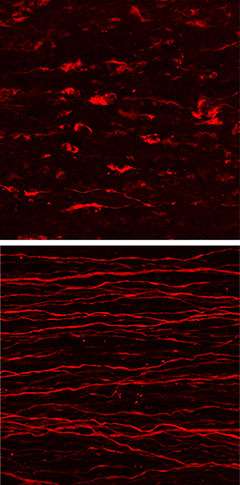Study detailing axonal death pathway may provide drug targets for neurodegenerative diseases

Axons connect neurons with each other to form the neural networks that underpin the vital functions of perception, motility, cognition, and memory. In many neurodegenerative disorders, from traumatic injury or toxic damage to diseases such as Alzheimer's or Parkinson's disease, axonal degeneration represents an essential pathological feature.
In a just-published study in Cell (January 15), a team led by scientists at The Rockefeller University identifies important new molecular details about the pathway that controls axonal degeneration following injury. Other studies have suggested the same pathway might regulate axonal death in a wide array of neurodegenerative diseases. If so, their findings could provide a potent set of novel targets for drug interventions to slow or halt those devastating diseases.
"A few components of this axonal death pathway have been identified over the years," says Marc Tessier-Lavigne, Rockefeller president, Carson Family Professor, head of the Laboratory of Brain Development and Repair, and senior author on the new study. "What we've done is to flesh out the pathway by detailing a key early point along the way, a classical signaling component called the MAP kinase pathway. The MAP kinase pathway, which is in many ways an environmental sensor pathway, is involved in the damage response, and if you block it, you can slow or block axonal degeneration."
The research team's experiments showed that a protein already implicated in degeneration, called Sarm1, functions to trigger the MAP kinase pathway, which itself is a three-level cascade of activation. They found that inactivation of the MAP kinase pathway at any of those three levels could block the death of damaged axons.
"With this knowledge in hand, we were able to show that this sensor pathway is activated very rapidly after injury, within minutes," says Jing Yang, a postdoctoral associate in the Tessier-Lavigne laboratory and first author on the study. "In fact, we were able to see that it is activated and then deactivated—we were able to follow that biochemically — and that there is then a lag before degeneration."
Additionally, the scientists found that an important downstream step was a loss of ATP, the central molecular player in the cellular energy cycle. ATP depletion and a resulting cellular energy deficit preceded axonal breakdown and death.
Next steps in the laboratory will include investigations into how widespread this regulatory step is in neurodegenerative diseases as diverse as Alzheimer's disease, Parkinson's disease, glaucoma, multiple sclerosis, and amyotrophic lateral sclerosis (better known as ALS or Lou Gehrig's disease). The researchers are trying to discover how activation of the MAP kinase pathway leads to the ATP loss and energy reduction. Further studies will also focus on elucidating the biochemical mechanism underlying activation of the MAP kinase pathway by Sarm1.
More information: "Pathological Axonal Death through a MAPK Cascade that Triggers a Local Energy Deficit." DOI: dx.doi.org/10.1016/j.cell.2014.11.053


















